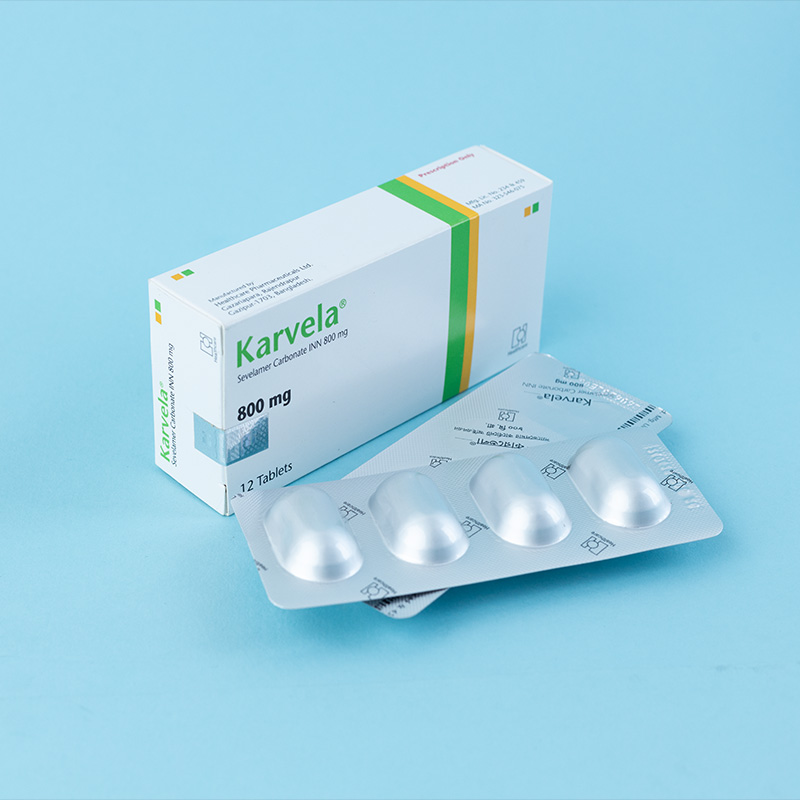Karvela® tablet 800 mg: Each film-coated tablet contains Sevelamer Carbonate INN 800 mg.

Sevelamer carbonate is indicated for:Control of hyperphosphataemia in adult patients receiving haemodialysis or peritoneal dialysis.
Control of hyperphosphataemia in adult patients with chronic kidney disease not on dialysis, with serum phosphorus ≥ 5.5 mg/dL or ≥ 1.78 mmol/L.

Sevelamer carbonate must be taken three times per day with meals.
Starting Dose for Adult Patients Not Taking a Phosphate Binder: The recommended starting dose of sevelamer carbonate is 2.4 g or 4.8 g per day, based on clinical needs and serum phosphorus levels. Subsequent titration should be done as per instructions.
For Patients Previously on Phosphate Binders:
Switching from Calcium Acetate:The recommended starting doses of sevelamer carbonate are based on the patient’s current calcium acetate dose:
1 tablet of Calcium Acetate 667 mg = 1 tablet of Sevelamer Carbonate 800 mg
2 tablets of Calcium Acetate 667 mg = 2 tablets of Sevelamer Carbonate 800 mg
3 tablets of Calcium Acetate 667 mg = 3 tablets of Sevelamer Carbonate 800 mg
Switching from Sevelamer Hydrochloride Tablets: For adult patients switching from sevelamer hydrochloride tablets to sevelamer carbonate tablets or powder, the same dose in grams should be used.

Serum phosphorus levels must be monitored, and the dose of sevelamer carbonate should be titrated by 0.8 g three times per day (2.4 g/day) increments every 2-4 weeks until an acceptable serum phosphorus level is reached. Regular monitoring is required thereafter. Patients should adhere to their prescribed diets. In clinical practice, treatment will be continuous based on the need to control serum phosphorus levels, with the daily dose expected to average approximately 6 g per day.

The safety and efficacy of Sevelamer carbonate have not been established in children below the age of 6 years.
Starting Dose for Pediatric Patients Not Taking a Phosphate Binder:For pediatric patients aged 6 years and older, the recommended starting dose is 0.8 g to 1.6 g taken three times per day with meals, based on the patient’s body surface area (BSA) category:
For BSA ≥0.75 to <1.2 m², the starting dose is 1 tablet per meal/snack, with titration by 0.4 g per dose.
For BSA ≥1.2 m², the starting dose is 2 tablets per meal/snack, with titration by 0.8 g per dose.

Serum phosphorus levels must be monitored and the dose of sevelamer carbonate titrated by 0.8 g three times per day (2.4 g/day) increments every 2-4 weeks until an acceptable serum phosphorus level is reached, with regular monitoring thereafter. Patients taking Sevelamer carbonate should adhere to their prescribed diets. In clinical practice, treatment will be continuous based on the need to control serum phosphorus levels, and the daily dose is expected to be an average of approximately 6 g per day.

In CKD patients on dialysis, the maximum dose studied was 14 grams of sevelamer carbonate and 13 grams of sevelamer hydrochloride. There are no reports of overdose with sevelamer carbonate or sevelamer hydrochloride in patients. Since sevelamer is not absorbed, the risk of systemic toxicity is low.

The most common adverse events include vomiting, nausea, diarrhea, dyspepsia, abdominal pain, flatulence, and constipation.

Sevelamer carbonate is contraindicated in:Patients with bowel obstruction.
Patients with known hypersensitivity to sevelamer carbonate, sevelamer hydrochloride, or any of the excipients.

Sevelamer carbonate did not alter the pharmacokinetics of digoxin, enalapril, iron, metoprolol, and warfarin.Sevelamer carbonate has demonstrated interaction with ciprofloxacin and mycophenolate mofetil; therefore, these drugs should be dosed separately from sevelamer carbonate.

Store at a temperature not exceeding 30°C in a dry place. Protect from light and moisture.Medicine: Keep out of reach of children.




